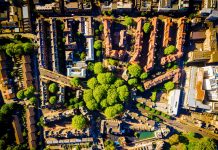Sarah Nelson, CEO of Foundation for Future London, discusses innovative ways to ‘design out crime’ to reduce crime rates and youth substance abuse in East London
Creating safe, inclusive environments through ‘designing out crime’ can transform East London into a thriving community. However, only through community collaboration – problem-solving together, building communities that reflect community heritage, culture, and talent, and empowering agents of change – will this have a true impact.
Traditional designing out crime is about thoughtfully shaping our physical spaces. It is where architects, designers, and urban planners can significantly reduce opportunities for crime, making the area safe for everyone – which we know can mean different things to different people.
A more proactive approach protects communities and goes one step further to involve them as active participants in the process to promote the wellbeing and prosperity of young and older residents. With safer spaces, young people can avoid the negative impacts of crime and instead focus on positive development. Improved academic performance, healthier social relationships, and more opportunities within and outside their communities are some benefits of environments designed to deter crime.
By focusing on this innovative approach, East London can become a beacon of safety and success, setting an example for other areas to follow.
London’s crime rate, with 95 crimes per 1,000 people, is the largest in the UK and currently outstrips the national average by 20%. It is even higher in East London, at 97% above the average.
Most commonly, these crimes involve violent and sexual offences, with 28 out of 1,000 residents impacted in some way, according to Crime Rate UK. The effects of this are far-reaching, with young people exposed to violence at risk of experiencing persistent stress, PTSD, depression and learning difficulties.
Addressing this intricate problem requires imaginative and forward-thinking solutions, and designing out crime offers a promising way forward.
The upturn in capital crimes
Why are there higher crime rates in East London than in the rest of the capital? There’s no single answer, but factors such as socioeconomic and unemployment problems and issues with urban density all have a part to play. Foundation for Future London, an independent grant-giving organisation supporting communities in East London to ensure equal opportunities and fair regeneration, has intimate knowledge of these challenges, experiencing firsthand the consequences of underfunding and lack of support from local authorities on the individuals and families they serve.
In East London, for instance, there are areas where poverty sits side-by-side with affluence, where there’s greater unemployment and lower wages, poor housing, and a lack of educational opportunities, all leading to inequalities with multiple barriers to accessing services. Several factors can lead to criminal behaviour, but for young people and many others, the lack of sustainable and equitable employment opportunities is key.
Urban environments with overcrowded conditions can also cause tensions. Often these are poorly designed, with bad lighting, neglected spaces and inferior facilities; all conditions ripe for crime. As outlined in criminology’s ‘broken windows’ theory, if our environments are not well designed or cared for, nor are they owned and invested in by our communities, this can lead to a spiral of downturn and negativity leading to more crime, disruption and a feeling of lack of safety.
Revitalising these urban spaces fosters community bonds, which have huge social and cultural effects on communities, creating authentic relationships and instilling a sense of ownership in public spaces. In East London, the Queen Elizabeth Olympic Park’s transformation has revived arts and culture in the area, with job opportunities and educational hubs as part of the East Bank cultural and educational quarter.
Meanwhile, in the local East London communities around East Bank, capital builds such as The Friends of Joiners Arms (FOJA) and The Yard – both grantees supported by our Westfield Stratford City funding – are committed to community consultation as part of their feasibility studies and building plans. FOJA has been working with its LGBTQ+ members in Hackney, while in Hackney Wick, The Yard is involving residents, community, artists, young people, disabled users and architects with its plans to refurbish an existing building to house a new theatre, bar/cafe and community space near their current site.
For many young people, a lack of employment opportunities coupled with a stretched education system adds another layer of complexity. Without jobs or prospects, young people can become disengaged from the community and turn to crime, perpetuating a cycle where other young people might copy their peers. Through the Westfield East Bank Creative Futures Fund, Foundation for Future London aims to mitigate this through its ‘Culture Exchange’ programme – which seeks to address talent and employment disparities in East London and across the UK.
The programme aims to connect young people, arts, cultural and innovation organisations, and communities in East London and the UK. In the 2023 pilot, 50 young people from East London, Birmingham, Preston and Sheffield took part in the programme. The goal is to help young people in these areas move forward in their careers. All participants could improve their confidence with their creative practices, develop their entrepreneurship, build confidence in their potential and self-initiative and raise aspirations for their futures.
Within this context, we must explore and enact practices like ‘designing out crime’ to disrupt these cycles.
A preventive measure in urban planning
Also known as Crime Prevention Through Environmental Design, designing out crime attempts to reduce the opportunities for crime through the strategic design of the urban environment.
It promotes natural surveillance – where people can see what is happening around them – and solidifies territorial boundaries, distinguishing public and private spaces to create a sense of ownership and prevent trespassing.
It also advances the importance of inclusive, community- centric spaces like gardens, parks and communal areas. This encourages connection within the community, which can lead to a collective sense of responsibility for the area’s safety and security. Most importantly, it encourages the empowerment of local people by involving them in the planning process. Designing out crime isn’t just about responding to crime but proactively preventing it—and involving the community aids in this process.
When placemaking is done inclusively, the benefits can enhance both the physical space and the social fabric of communities. Inclusive placemaking ensures that the planning process heeds the voices and ideas of a broad spectrum of community members. This diversity of input leads to spaces that represent the entire community, not just a select few.
Here, we see the connection between the first generation of designing out crime – which focuses on the physical design of the environment- and the second generation, where the focus includes social and community factors that charities, such as Foundation for Future London, make their true impact.
The evidence for designing out crime is clear: case studies from global cities, such as Barcelona, Singapore and Melbourne, and UK housing estates show that well-designed environments can significantly lower crime rates, leading to a safer, more vibrant community life.
The impact of the physical environment on crime rates and mental health
The physical environment has a pronounced impact on crime rates and community mental health.
Thoughtful design, focusing on safety through well-lit, navigable spaces and an opportunity to have a say in improvements to their local area, helps residents develop a sense of security and social cohesion, reducing feelings of stress and isolation. Green spaces and aesthetically pleasing spots, with public art and community-designed gardens and facilities, give residents areas to exercise, relax, and escape from urban stresses.
Additionally, involving the community in urban design cultivates a sense of ownership and pride, enhances social oversight, and increases the willingness to prevent antisocial behaviour. This is so important for engaging young people.
The design of the physical environment is critically linked to both crime rates and community mental health. By providing inclusive and vibrant areas for youth engagement, we create a platform for positive social interaction and community wellbeing.
Combating youth substance abuse and mental health challenges
Cannabis remains the most common substance (87%) that young people are provided treatment for, according to data from the National Drug Treatment Monitoring System (NDTMS). Young people often adopt behaviours they see around them, and this is the case in areas with high crime rates, such as drug and alcohol abuse, self-harm, and anti-social behaviour. An additional absence of community support only heightens the sense of marginalisation they feel, further pushing them towards antisocial behaviour.
To combat this, we need targeted programs and robust support systems. By providing at-risk young people with mentorship, education, training, volunteering initiatives, and mental health resources such as counselling, we can build more inclusive communities and empower them to make healthier and more positive choices.
Project Zero: a case study in community engagement
Engaging young people in activities to promote social inclusion and reduce offending behaviour, Project Zero aims to see a year where there have been no deaths of a young person due to knife crime or youth violence.
Its methods are rooted in inclusivity and innovation – offering creative and engaging activities that are free and tailored to reach those outside mainstream education. With a strong emphasis on employability, Project Zero provides young individuals with practical paths toward stable and fulfilling careers.
In 2022, Foundation for Future London awarded a grant to Project Zero for young people in Newham and Waltham Forest, through the Westfield East Bank Creative Futures Fund funded by Westfield Stratford City, for their project Virtual Futures. This creative learning project used virtual reality art to encourage young people of colour to make the most of their digital and creative skills.
Strategies for transforming East London
To halt the rise in crime rates and guarantee young people brighter futures, we need to develop strategies that will transform East London moving forward. That means integrating designing out crime into large urban development projects to create safe, stimulating environments where housing, parks, and community spaces are inclusive and reflect community needs.
For this transformation to be a success, local government, law enforcement, urban planners, and community groups—tapping into local talent, knowledge, creativity, heritage, and culture – need to come together to find ways of creating safety and community welfare. This might be done through regular forums, which allow resident voices to shape their communities and government and NGO collaborations that can provide robust, sustainable programmes.
With a shared vision, these strategies can set the stage for a resilient new East London.















